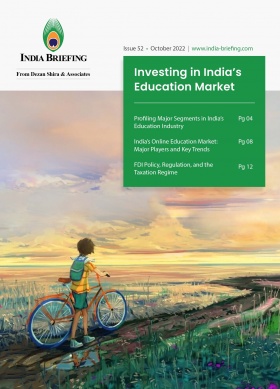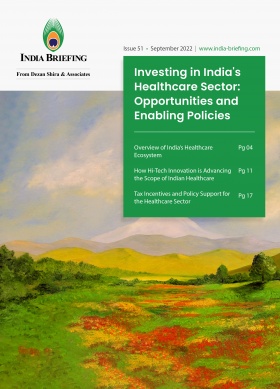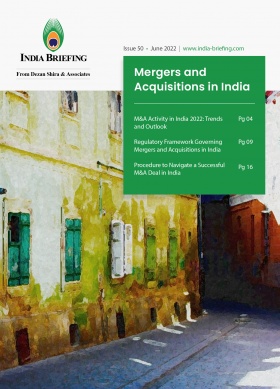Operational Guidelines for India’s Drone PLI Scheme: Target Segments, Disbursal of Incentives
India wants to advance the use and production of drones in the country and has released operational guidelines to implement the sector-specific PLI Scheme.
The operational guidelines for the Production Linked Incentive (PLI) Scheme for Drones and Drone Components in India have been released by the Ministry of Civil Aviation. The guidelines were notified November 29, 2022 for the benefit of all stakeholders and the public.
The PLI Scheme had been notified and came into effect on September 30, 2021.
Guidelines for the operation of the PLI Scheme for Drones and Drone Components
Key aspects of the guidelines touch on the following: definitions, qualification and eligibility criteria, application and online portal, the competent authorities, and calculation and disbursal of incentives.
These operational guidelines are meant to facilitate smooth implementation of the PLI Scheme. In case of any inconsistency between the guidelines and scheme, the provisions of the PLI Scheme shall prevail.
Eligibility
Companies registered in India that manufacture drones and/or drone components have been considered for the PLI Scheme. The manufacturing operations can be carried out at one or more location in India.
The PLI Scheme is applicable to group company(ies), start-ups, and micro, small, and medium enterprises (MSMEs).
|
Minimum Annual Sales Turnover for Claiming PLI |
|||
|
Indian MSME and start-ups |
Indian non-MSME |
||
|
Drone (INR) |
Component (INR) |
Drone (INR) |
Component (INR) |
|
20 million (approx. US$242,376) |
5 million (approx. US$60,594) |
40 million (approx. US$484,751) |
10 million (approx. US$121,188) |
Target segments
The target segments cover drones and drone components. The eligible products under drone components include:
- Airframe, propulsion systems, (engine and electric), power systems, batteries and associated components, launch and recovery systems.
- Inertial Measurement Unit, Inertial Navigation System, flight control module, ground control station, and associated components.
- Communication systems (radio frequency, transponders, satellite-based, etc.).
- Cameras, sensors, spraying systems, and related payload, etc.
- ‘Detect and Avoid’ system, emergency recovery system, trackers, etc. and other components critical for safety and security.
- Software for drone and drone components.
The list of eligible drones and drone components may be modified by the federal government from time to time. Also, the drone components for which the PLI is being claimed must be used solely in the manufacturing of a drone.
Financial outlay
The total financial outlay during three years of implementation of the PLI Scheme for Drones and Drone Components is capped at INR 1.2 billion ( approx. US$14.54 million).
If the calculated incentive payout under this Scheme exceeds the budget for a particular year, it will be reduced on pro-rata basis for each applicant. Total production-linked incentive for each manufacturer is capped at INR 300 million (approx. US$3.63 million).
Review and monitoring
The Project Management Agency (PMA) will be responsible for provision of secretarial, managerial, and implementation support and other responsibilities as deputed to it by the civil aviation ministry.
The PMA will inter-alia be responsible for:
- Appraisal of applications and verification of eligibility
- Examining claims for disbursement of PLI
- Compilation of data regarding progress of the Scheme and its performance – incremental investment, incremental sales, purchases of drones and drone components
- Monitoring to avoid duplication of claims or benefits due to any changes in accounting policy
As such, the PMA can request for additional information, details, undertakings, certificates, and documents from PLI applicants as deemed necessary.
At a higher level, the Empowered Group of Secretaries (EGoS) chaired by the Cabinet Secretary will conduct periodic reviews of the eligible companies with respect to their investments, employment generation, production, and value addition under the Scheme.
The EGoS may revise incentive rates, ceilings, target segment(s), and eligibility criteria as deemed appropriate during the duration of the Scheme.
The members of the EGoS are:
- Cabinet Secretary( chairperson)
- CEO, Niti Aayog
- Secretary, Department for Promotion of Industry and Internal Trade (member convenor)
- Secretary, Department of Commerce
- Secretary, Department of Revenue
- Secretary, Department of Economic Affairs
- Secretary, Ministry of Civil Aviation
All approved applicants must submit a self-certified Quarterly Review Report (QRR) within 30 days from the end of each quarter in the format provided in Annexure-4 of the Operational Guidelines. Moreover, to avoid financial malpractice, applicants have to submit two formats of undertakings and duly signed the CEO/MD/Director alongside their designation and authorization to do so. These two formats of undertaking – Format-A and Format-B – are provided in Annexure-5.
In case there is a change in the shareholding pattern during the tenure of the Scheme – the Registrar of Companies (RoC) is updated – and then the PMA must be notified. If such change in shareholding pattern or ownership of the applicant company leads to a change in the nature of the company or nature of partnership during the tenure of the Scheme, the PMA notifies the competent authority for considering the disbursal of incentives.
Audit
The Scheme requires audit by an external auditor (chartered accountant or cost accountant) appointed by the Project Management Agency/Ministry of Civil Aviation and whose cost is borne by the PLI applicant.
Calculation of incentive
The incentive applicable for an approved applicant is computed as: Eligible Value Addition (EVA) × 20%
- Where EVA = Eligible Sales Turnover (net of GST) – Eligible Purchase Cost (net of GST)
- EVA should be at least 40% of the eligible sales turnover for the year
- In case of return of sales, the Gross Sales shall be reduced by the amount corresponding to such return of sales. If the corresponding sales have been considered for claim processing for the earlier period, the sales return shall be adjusted with Gross Sales for the period in which the actual sales return takes place.
- A manufacturer failing to meet the threshold for EVA in India for a particular year will not receive the PLI incentive. The manufacturer will receive this incentive in the subsequent year if they make up the said shortfall in rupee terms in the subsequent year.
- Excess incentive paid to any applicant will be adjusted in the incentive paid the next year, otherwise it must be returned. Otherwise, the amount owed will be the excess incentive plus interest charged (3 years SBI MCLR).
Disbursal of incentive
Disbursement claim for incentives must be filed annually within 12 months from the end of the financial year for the claims pertaining to FY 2021-22 and within six months from the end of the financial year to which the claim pertains for remaining tenure of the Scheme.
The PMA and competent authority will examine the claims and process the incentive payments after all the pre-disbursal formalities are completed.
The incentives are disbursed in the form of direct bank transfer or through any other mechanism of adjustment in the name of the applicant only.
About Us
India Briefing is produced by Dezan Shira & Associates. The firm assists foreign investors throughout Asia from offices across the world, including in Delhi and Mumbai. Readers may write to india@dezshira.com for more support on doing business in in India.
We also maintain offices or have alliance partners assisting foreign investors in Indonesia, Singapore, Vietnam, Philippines, Malaysia, Thailand, Italy, Germany, and the United States, in addition to practices in Bangladesh and Russia.
- Previous Article Splitting Posts of Chairman and MD/CEO Now Voluntary: SEBI
- Next Article Maharashtra Revises Single-Use Plastic Ban: Items Now Allowed for Production and Use









